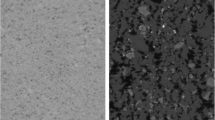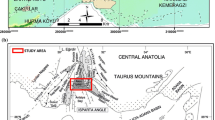Abstract
Stromboli island has a complex geological history with repeated changes in the volcanic activity alternating with destructive events, caldera collapses and flank landslides. The last activity resulted in the creation of the Sciara del Fuoco depression which was modified by the recent 2002–2003 landslide. The variation in lithology, degree of tectonization and disturbance has resulted in the presence of a wide spectrum of geotechnical materials. This paper summarises the physical and mechanical properties of Stromboli’s intact rocks, rock masses and loose deposits, based on field surveys and laboratory tests. A new classification of the rock succession is introduced and four lithotechnical units defined: Lava, Lava-Breccia, Breccia and Pyroclastic deposit. The range of variability in bulk volume, porosity, intact rock compressive strength and geological strength index is presented. The Hoek and Brown’s failure criterion was applied for each lithotechnical unit and the rock mass friction angle, apparent cohesion, tensile and compressive strength, global strength and modulus of deformation calculated in a specified stress range.
Résumé
L’histoire géologique de l’île du Stromboli est complexe, avec une activité volcanique ayant donné lieu à des événements destructeurs, des effondrements de caldeiras et des glissements des flancs du volcan. La dernière période d’activité a eu pour conséquence la formation de la dépression de la Sciara del Fuoco, qui fut modifiée par le récent glissement de 2002–2003. La nature lithologique complexe du site, le degré de tectonisation et les remaniements des matériaux expliquent la diversité des propriétés géotechniques des matériaux présents. Cet article synthétise les propriétés physiques et mécaniques des roches intactes du Stromboli, des masses rocheuses et des dépôts meubles, à partir de prospections de terrain et d’essais de laboratoire. Une nouvelle classification des roches présentes sur ce site est introduite et quatre unités lithologiques sont définies: les laves, les laves-brèches, les brèches, les pyroclastites. Les domaines de variation des paramètres: densité, porosité, résistance à la compression simple et GSI - indice de résistance géologique sont présentés. Le critère de rupture de Hoek et Brown a été appliqué pour chaque unité lithologique et les paramètres relatifs à la masse rocheuse: angle de frottement, cohésion apparente, résistance à la traction et à la compression, résistance globale et module de déformation ont été calculés pour un domaine de contrainte particulier.








Similar content being viewed by others
References
Apuani T, Corazzato C, Cancelli A, Tibaldi A (2005) Stability of a collapsing volcano (Stromboli, Italy): limit equilibrium analysis and numerical modelling. In: Gudmundsson A, Acocella V (eds) Special volume “The Tectonics and physics of volcanoes”. J Volcanol Geoth Res 144(1–4):191–210
ASTM, American Society for Testing and Materials (1987) Annual book of ASTM standards. Soil and rock; building stones; geotextiles, 04.08, D 2487, pp 395–408
Beget JE, Kienle J (1992) Cyclic formation of debris avalanches at Mt. St. Augustine volcano. Nature 356:701–704
Bieniawski ZT (1989) Engineering rock mass classification. Wiley, New York
Bonaccorso A, Calvari S, Garfi G, Lodato L, Patané D (2003) Dynamics of the December 2002 flank failure and tsunami at Stromboli volcano inferred by volcanological and geophysical observations. Geophys Res Lett 30(18):1941. DOI–10.1029/2003GL017702
Brock E, Franklin JA (1972) The point-load strength test. Int J Rock Mech Min Sci Geomech Abstr 9:669–697
Concha-Dimas A, Watters RJ (2003a) Preliminary evaluation of volcanic flank stability using finite difference modeling: Citlaltépetl volcano, Mexico. In: 12th Panamerican conference on soil mechanics and geotechnical engineering. Soil Rock America 2003, June 22–26, Boston
Concha-Dimas A, Watters RJ (2003b) Evaluating avalanche generation by 2D finite difference analysis at Pico de Orizaba, Mexico. AGU-EGS-EUG Joint Meeting 2003. Nice, France. Geophysical Research Abstracts 5:07842. European Geophysical Society
Dinis da Gama C, Ribeiro e Sousa L (eds) (2002) Workshop on volcanic rocks. In: ISRM international symposium on rock engineering for mountainous regions, Eurock 2002. November 25–28, Funchal, Portugal, 2002. Sociedade Portuguesa de Geotecnia, Lisboa, Portugal
Donnadieu F, Merle O, Besson JC (2001) Volcanic edifice stability during cryptodome intrusion. Bull Volcanol 63:61–72
Elsworth D, Day S (1999) Flank collapse triggered by intrusion: the Canarian and Cape Verde Archipelagoes. J Volcanol Geoth Res 94(1–4):323–340
Elsworth D, Voight B (1996) Evaluation of volcano flank instability triggered by dyke intrusion. In: McGuire B (ed) Volcano Instability on the earth and other planets. Geol Soc Spec Publ 110:45–53
Francalanci L (1987) Volcanological and magmatological evolution of the island of Stromboli (Aeolian islands): relationship between calc-alkaline and shoshonitic magmatism (In Italian). PhD Thesis, University of Florence, 351 pp
Gabbianelli G, Romagnoli C, Rossi PL, Calanchi N (1993) Marine geology of the Panarea-Stromboli area (Aeolian Archipelago, Southeastern Tyrrhenian sea). Acta Vulcanologica 3:11–20
Hoek E (1983) Strength of jointed rock masses. Geotechnique 33:187–223
Hoek E, Brown ET (1980) Empirical strength criterion for rock masses. J Geotech Engineering Div, ASCE106 (GT9):1013–1035
Hoek E, Brown ET (1988) The Hoek-Brown failure criterion—a 1988 update. In: Curran JH (ed) Proceedings of 15th Canadian rock mech Symp, Toronto, pp 31–38
Hoek E, Brown ET (1997) Practical estimates of rock mass. Int J Rock Mech Min Sci 34:1165–1186
Hoek E, Marinos P, Benissi M (1998) Applicability of the geological strength index (GSI) classification for very weak and sheared rock masses. The case of the Athens Schist Formation. Bull Eng Geol Env 57:151–160
Hoek E, Carranza-Torres CT, Corkum B (2002) Hoek-Brown failure criterion-2002 edition. In: Proceedings of North American Rock Mechanics Society-TAC Conference, Toronto, July 2002, 1:267–273
Hornig-Kjarsgaard I, Keller J, Koberski U, Stadlbauer E, Francalanci L, Lenhart R (1993) Geology, stratigraphy and volcanological evolution of the Island of Stromboli, Aeolian Arc, Italy. Acta Vulcanologica 3:21–68
Hudson JA, Brown ET, Rummel F (1972) The controlled failure of rock discs and rings loaded in diametral compression. Int J Rock Mech Min Sci 9:241–248
Hurlimann M, Garcia-Piera JO, Ledesma A (2000a) Causes and mobility of large volcanic landslides: application to Tenerife, Canary Islands. J Volcanol Geoth Res 103(1–4):121–134
Hurlimann M, Martì J, Ledesma A (2000b) Mechanical relationship between catastrophic volcanic landslides and caldera collapse. Geophys Res Lett 27:2393–2396
International Society for Rock Mechanics (1981) Rock Characterization, Testing and Monitoring—ISRM Suggested Methods. Pergamon, London
International Society for Rock Mechanics (1985) Suggested method for determining point load strength. Int J Rock Mech Min Sci Geomech Abstr 22:51–63
Iverson RM (1995) Can magma injection and groundwater forces cause massive landslides on Hawaiian volcanoes? J Volcanol Geoth Res 66(1–4):295–308
Komorowski JC, Navarro C, Cortes A, Siebe C (1994) The unique tendency for recurrent collapse at Colima volcanoes (Mexico): the challenge of reconciling geologic evidence with 14 C chronology, implications for hazard assessment. In: Proceedings of International Conference on volcano instability on the earth and other planets. The Geological Society of London, 1994
Kwaśniewski M (2002) A note on the triaxial strength of volcanic rocks. In: Dinis da Gama C, Ribeiro e Sousa L (eds) Workshop on volcanic rocks. ISRM international symposium on rock engineering for mountainous regions, Eurock 2002. November 25–28, Funchal, Portugal, 2002, 27–36. Sociedade Portuguesa de Geotecnia, Lisboa, Portugal
Lama RD, Vutukuri VS (1978) Handbook on mechanical properties of rocks—testing techniques and results, vol II. Trans Tech Publications, Clausthal, Germany
Lenat JF, Vincent P, Bachelery P (1989) The off-shore continuation of an active basaltic volcano: Piton de la Fournaise (Reunion Island, Indian Ocean); structural and geomorphological interpretation from sea beam mapping. J Volcanol Geoth Res 36:1–36
Pasquaré G, Francalanci L, Garduño VH, Tibaldi A (1993) Structure and geological evolution of the Stromboli volcano, Aeolian islands, Italy. Acta Vulcanologica 3:79–89
Rosi M (1980) The island of Stromboli. Rendiconti Società Italiana Mineralogia e Petrografia 36:345–368
Schultz RA (1995) Limits on strength and deformation properties of jointed basaltic rock masses. Rock Mech Rock Eng 28(1):1–15
Schultz RA (1996) Relative scale and the strength and deformability of rock masses. J Struct Geol 18(9):1139–1349
Serrano A, Olalla C, Perucho Á (2002) Evaluation of non-linear strength lavas for volcanic agglomerates. In: Dinis da Gama C, Ribeiro e Sousa L (eds) Workshop on volcanic rocks. ISRM international symposium on rock engineering for mountainous regions, Eurock 2002. November 25–28, Funchal, Portugal, 2002, 53–60. Sociedade Portuguesa de Geotecnia, Lisboa, Portugal
Siebert L, Beget JE, Glicken H (1995) The 1883 and late-prehistoric eruptions of Augustine volcano, Alaska. J Volc Geoth Res 66(1–4):367–395
Sousa J, Voight B (1995) Multiple-pulsed debris avalanche emplacement at Mount St. Helens in 1980: evidence from numerical continuum flow simulation. J Volcanol Geoth Res 66(1–4):227–250
Sundaram PN, Corrales JM (1980) Brazilian tensile strength of rocks with different elastic properties in tension and compression. Int J Rock Mech Min Sci Geomech Abstr 17:131–133
Thomas ME, Petford N, Bromhead EN (2004) volcanic rock-mass properties from Snowdonia and Tenerife: implication for volcano edifice strength. J Geol Soc 161:939–946
Tibaldi A (2001) Multiple sector collapses at Stromboli volcano, Italy: how they work. Bull Volcanol 63:112–125
Tibaldi A, Pasquaré G (2005) Geological map of Stromboli. national project on 1:50,000 Prototype Map Atlas, CNR-SGN-CARG, with a 1:10,000 map (in press)
Tibaldi A, Pasquaré G, Francalanci L, Garduño VH (1994) Collapse type and recurrence at Stromboli volcano, associated volcanic activity, and sea level changes. Accademia dei Lincei Atti dei Convegni Lincei Roma 112:143–151
Tibaldi A, Corazzato C, Apuani T, Cancelli A (2003) Deformation at Stromboli volcano (Italy) revealed by rock mechanics and structural geology. Tectonophysics 361:187–204
Voight B (2000) Structural stability of andesite volcanoes and lava domes. Phil Trans R Soc London 358:1663–1703
Voight B, Elsworth D (1997) Failure of volcano slopes. Geotéchnique 47(1):1–31
Voight B, Janda RJ, Glicken H, Douglass PM (1983) Nature and mechanics of the Mount St Helens rockslide-avalanche of 18 May 1980. Geotéchnique 33:243–273
Watters RJ, Zimbelman DR, Bowman SD, Crowley JK (2000) Rock mass strength assessment and significance to edifice stability, Mount Rainier and Mount Hood, Cascade Range volcanoes. Pure Appl Geophys 157:957–976
Zimbelman DR, Watters RJ, Firth IR, Breit GN, Carrasco-Nuñez G (2004) Stratovolcano stability assessment methods and results from Citlaltépetl, Mexico. Bull Volcanol 66(1):66–79
Acknowledgements
The research was supported by Gruppo Nazionale per la Vulcanologia—INGV (Italy) and FIRB-MIUR 2001. It is a contribution to the UNESCO-IUGS-IGCP project 455 “Effects of basement structural and stratigraphic heritage on volcano behaviour and implications for human activities”.
Author information
Authors and Affiliations
Corresponding author
Rights and permissions
About this article
Cite this article
Apuani, T., Corazzato, C., Cancelli, A. et al. Physical and mechanical properties of rock masses at Stromboli: a dataset for volcano instability evaluation. Bull Eng Geol Environ 64, 419–431 (2005). https://doi.org/10.1007/s10064-005-0007-0
Received:
Accepted:
Published:
Issue Date:
DOI: https://doi.org/10.1007/s10064-005-0007-0




